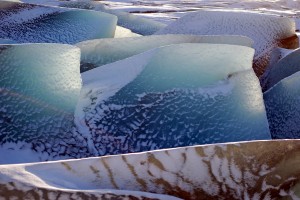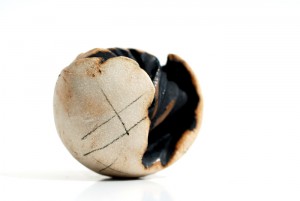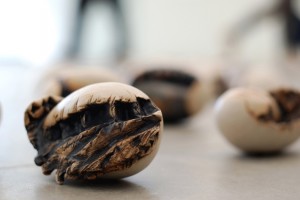Â
I am a ceramicist whose work is located within the arena of sculpture and installation. I draw my primary inspiration from natural shapes like landscapes and ripples in snow that create rhythms, themes, structures and harmonic sequences. Parallel with developing the ceramic sculptures, I explore my work from a philosophical angle, researching the links between non-representational art, music and philosophy, which bring further depth and in some cases tangible features to the work. I work with ceramics in untraditional ways by distancing myself from traditional ceramic techniques, thinking of it as no more than a material that can be used in any way, such as using charcoal or acrylic paint, as long as it is beneficial for the meaning of the work.
The development of a piece is ongoing processes that potentially can be never-ending in terms of the surface. By the use of both materials that are permanent in regard of firing hi temperature and materials that will disappear. I add on features of ideas and thoughts I have regarding the development of my work all through the process, even in the gallery space, working site-specific in a spontaneous manner. When the show is over, I re-fire the work, which leaves only some traces from the previous show and the work will then be resurfaced for the next. The work will therefore have traces from the journey it has been through, though the most recently added features will always be the most apparent.
The process
The main source of inspiration for my work comes from nature. When starting up a new project I go on a journey with my camera to capture essential shapes that attract me from the landscape. At this stage, I do not think of what the pictures might inspire, I just capture what I immediately see as beauty. I look for shapes that create rhythms and good compositions through the camera lens. The pictures are usually of lines in landscapes or the ripples on the ground, made by the wind. They can be close-ups or panoramic views. As I am in these locations, I also try to take in and remember the feelings I have, usually those of great humility when in surroundings of such grandeur. Through my camera lens, I can discover lines and shapes in nature that make my eyes run and my throat feel thick; when I have the same feeling about a sculpture or an installation I know I am on to something. The philosopher George Santayana wrote about this in his classical work, The sense of beauty, he characterizes the natural landscape as follows:
‘The natural landscape is an indeterminate object; it almost always contains enough diversity to allow… great liberty in selecting, emphasizing, and grouping its elements, and it’s furthermore rich in suggestion and in vague emotional stimulus. A landscape to be seen has to be composed… then we feel that the landscape is beautiful… the promiscuous natural landscape cannot be enjoyed in any other way’. (Feagin, Maynard, 1997. Aesthetics. P. 31-32).  When I use my camera photographing landscapes, I can more easily find compositions, both in close-ups and panoramic views that draw my attention than with my bare eye.
On return, I start studying the photos, the sketches, and the memoirs I have gathered. I examine them to see what they have in common that attracts me. I make notes of the essence of what I have discovered, but from now on, I use my inspiration only at a subconscious and abstract level. When I move on to the making of ceramic sculptures, I let them appear intuitively with the impressions from my trip in mind. Parallel with developing the ceramic sculptures I like to research my source of inspiration from a philosophical angle. I am attentive about the fact that reading existing theories on the subject area can bring further depth to what I am trying to say with my work. In some cases, it can also bring features that are more direct as quotes from theories I like, and mind maps that link my interests as an addition on the sculptures and installation surfaces. As a part of my process of exploring formal and conceptual problems that parallels the process of working in clay I make two-dimensional compositions. My drawings are almost like free writing in which authors often engage before entering a substantial text, but there are not only preliminary drawings, they allow me to explore formal and conceptual problems at an accelerated rate. Annabeth Rosen says about her drawings
‘Working in ceramics is labour intensive and time consuming, and a drawing is far more immediate’ (Ceramics: art and Perception, No. 72 2008, P.63)
However, because drawings are immediate they automatically get more energetic than my ceramic sculptures. To bring more energy and immediacy to my sculptures I bring the techniques from drawing and painting on canvas to the ceramic work. By the use of both materials that are permanent in regard of firing hi temperature and materials that will disappear, the work will have traces from the journey it has been through, though the most recently added features will always be the most apparent.
I determine when a sculpture is finished through intuition; I have to feel when it is right to stop. In the making of each sculpture, I use the memories of the aesthetical emotion I had on the journey when seeing something beautiful as a guide to determine when to stop working on a sculpture, and which of these to keep and which to discard. When I recognise the aesthetic emotion, I put the sculpture away and start on a new one. Clive Bell writes about the aesthetic emotion in The Aesthetic Hypothesis:
‘That there is a particular kind of emotion provoked by works of visual art, and that this emotion is provoked by every kind of visual art, by pictures, sculptures…, is not disputed, I think, by anyone capable of feeling it. This emotion is called the aesthetic emotion; and if we can discover some quality common and peculiar to all the objects that provoke it, we shall have solved what I take to be the central problem of aesthetics. We shall have discovered the essential quality in work of art, the quality that distinguishes works of art from all other classes of objects’. (Feagin, Maynard, 1997. P. 15)
I stop when I see beauty and aesthetics, and not necessarily when others see it, I have discovered that those who share passionate interest in one area, to some extent also share fascination in other areas as in art. This could mean that those who get the aesthetical emotion from the same sources as me might appreciate the same beauty in art as me.
When exhibiting, I like the idea of bringing my sculptures to the exhibiting space and then spending time exploring in what ways I can make it attractive for that specific gallery and exhibition. At the time as setting up my work in a gallery, I have to distance myself from the sculpture pieces to be able to be playful and experimental with them. I try to think of my sculptures as found objects and expand my working ways from traditional ceramic techniques. This can take various forms like exhibiting in a pile, drawing on the sculptures or even using household paint to bring my expressional 2D visual language to 3D sculptures.
Norwegian
Marit har studert keramisk kunst fra Kunsthøgskolen i Oslo (SHKS) og har mastergrad fra University for the Creative Arts (UCA). Hun har spesialisert seg innen installasjon og skulptur og har hatt separat- og gruppeutstillinger  i Norge og England.
Inspirasjon til arbeidene sine henter Marit fra landskap, krusninger i snøen, linjer i isen eller andre naturlige former hvor hun finner temaer, strukturer eller rytmer som interesserer henne.
Installasjonen er en refleksjon over ønsket om Ã¥ fange og ta med hjem naturinntrykk. Skulpturene, som oppstÃ¥r gjennom improvisasjon pÃ¥ samme mÃ¥te som musikk blir til i en â€jam-sessionâ€, representerer essensen av naturen og er presentert i en komposisjon med stÃ¥l, hvor Marit søker harmoni med rommet de er presentert i.
Om prosessen
Hovedinspirasjonskilden til Marits arbeider er naturen. NÃ¥r hun starter et nytt prosjekt, legger hun først ut pÃ¥ en reise med kameraet for Ã¥ fange former som hun tiltrekkes av og som hun synes er spennende. PÃ¥ dette stadiet tenker hun ikke pÃ¥ hva bildene konkret kan inspirere til, men ser etter motiver som hun i øyeblikket opplever som vakre. Motiver som fÃ¥r øynene hennes til Ã¥ renne og halsen til Ã¥ føles tykk. Hun forsøker Ã¥ memorere opplevelsen – â€NÃ¥r jeg har den samme følelsen ovenfor en skulptur eller installasjon, vet jeg at jeg er pÃ¥ sporet av noeâ€. Filosofen George Santayana skrev om dette i sitt klassiske verk, ‘The sense of beauty’, Han karakteriserer naturlige landscaper som følgende:
‘The natural landscape is an indeterminate object; it almost always contains enough diversity to allow… great liberty in selecting, emphasizing, and grouping its elements, and it’s furthermore rich in suggestion and in vague emotional stimulus. A landscape to be seen has to be composed… then we feel that the landscape is beautiful… the promiscuous natural landscape cannot be enjoyed in any other way’. (Feagin, Maynard, 1997. Aesthetics. P. 31-32
Når Marit kommer hjem fra en reise studerer hun bildene og skissene hun har samlet og ser på hvilke elementer som tiltrekker henne og hva de har til felles. Hun lager deretter tankekart hvor tanker og beskrivelser av det hun har fotografert og erfart blir blandet med filosofiske tekster og hvor hun trekker linjer fra natur til kunst.
I det hun begynner Ã¥ jobbe pÃ¥ skulpturene legges imidlertid inspirasjonsmaterialet bort. I denne delen av prosessen stÃ¥r det intuitive sentralt. â€Jeg bruker minner og følelser jeg hadde pÃ¥ reisen for Ã¥ fastslÃ¥ nÃ¥r jeg skal stoppe arbeidet pÃ¥ skulpturen, hvilke jeg skal ta vare pÃ¥ og hvilke som blir forkastet. NÃ¥r jeg kjenner igjen ’ the aesthetic emotion’ legger jeg bort skulpturen, og begynner pÃ¥ en nyâ€. Clive Bell skriver om ‘the aesthetic emotion’ iThe Aesthetic Hypothesis:
‘That there is a particular kind of emotion provoked by works of visual art, and that this emotion is provoked by every kind of visual art, by pictures, sculptures…, is not disputed, I think, by anyone capable of feeling it. This emotion is called the aesthetic emotion; and if we can discover some quality common and peculiar to all the objects that provoke it, we shall have solved what I take to be the central problem of aesthetics. We shall have discovered the essential quality in work of art, the quality that distinguishes works of art from all other classes of objects’. (Feagin, Maynard, 1997. Aesthetics. P. 15).
Den siste delen av prosessen er å utforske posisjoneringen av skulpturene i forhold til hverandre og omgivelsene. Skulpturene er variasjoner over et tema, som avhengig av hvordan de blir plassert skaper ulike harmonier.




